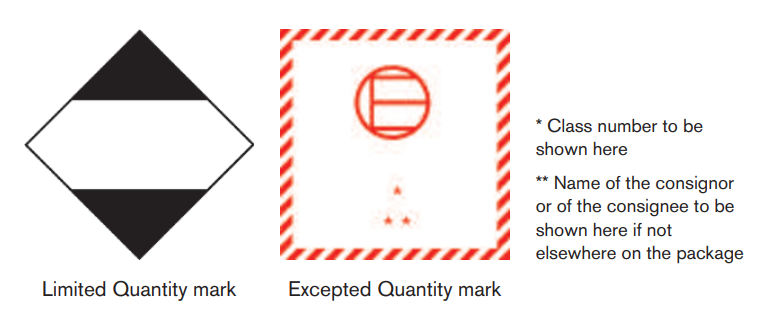Step 3: Marking and labelling of packages
Safe transport and handling procedures can only be maintained during the transport of dangerous goods by sea if everyone involved has ready access to information about the risks presented by the goods concerned – container packers/handlers, the ship’s crew, the emergency services etc.
Appropriate and readily recognisable warnings on packages can help achieve this objective.
The IMDG Code requires a range of warnings – in the form of marks and labels – to be applied to packages being shipped by sea.
It is the consignor’s (shipper’s) duty to ensure that packages containing dangerous goods display all the marks and labels required for the sea journey.
The term ‘marking’ refers to the application of:
- UN Number (Section 5.2.1.1)
- The Proper Shipping Name (PSN) (Section 5.2.1.1)
- Marine pollutant mark (as applicable) (Section 5.2.1.6)
- Orientation marks (as applicable) (Section 5.2.1.7)
- Limited quantity mark (as applicable) (Section 3.4.5)
- Excepted quantity mark (as applicable) (Section 3.5.4)
- Any class or substance specific marks (as applicable)
– see Section 5.2.1 for specific details
The term ‘labelling’ refers to the application of:
- the hazard class diamond label (Section 5.2.2)
- sub-hazard diamond labels (as applicable) (Section 5.2.2)
- any class specific label (as applicable) – see Section 5.2.2 for specific details
Let’s look at an example:

Here we can see the following marks and labels:
UN Number : UN 2826
PSN: ETHYL CHLOROTHIOFORMATE

Orientation mark Marine pollutant mark
Note: in the image above you can also see the UN Packaging mark in the bottom left hand corner (4G/X100/S/04USA/ALC), as described in section A2.7 above.
When applying marks and labels the following provisions must be adhered to:
The required marks and labels only need to be displayed once on a package, except as follows:
- IBCs exceeding 450L capacity and large packagings must be marked and labelled on two opposite sides
- Orientation arrows (where required – see Section 5.2.1.7) must always be displayed on two opposite sides
On a combination packaging, the relevant transport marks and labels are only required on the outer packaging e.g. fibreboard box; they are not needed on inner packagings.
For unpackaged articles, the marks and labels must be displayed on the article itself or on its cradle or handling, storage or launching device.
Both marks and labels must still be identifiable on packages surviving at least three months’ immersion in the sea.
Wherever possible, marks and labels must be located on the same surface of the package and not be obscured by any part of the package or attachment to it. Any subsidiary hazard label(s) must be displayed next to the primary hazard label.
Labels must satisfy the provisions in Section 5.2.2.2 and conform, in terms of colour, symbols, numbers and general format, to the specimen labels shown in Section 5.2.2.2.2. They must be in the form of a square set at an angle of 45° (diamond-shaped) with minimum dimensions of 100 mm by 100 mm, except in the case of packages of such dimensions that they can only bear smaller labels – see Section 5.2.2.2.1.1 for an illustration of this.
The label may include text such as the UN Number, or words describing the hazard class (e.g. “corrosive”) provided the text does not obscure or detract from the other required label elements.

Class 8 label and Class 3 sub-hazard labels
Limited Quantity and Excepted Quantity marks
Packages shipped in accordance with the provisions for “Limited Quantities” or “Excepted Quantities” are not subject to the standard marking and labelling requirements highlighted above. They do not need to be marked with the PSN and UN Number of the contents or a marine pollutant mark and no danger or
subsidiary hazard labels are needed. Instead, they have their own specific identifying marks as follows:

Note: as well as ensuring that packagings are marked and labelled to identify the hazards contained within, the CTU containing the packagings must also, in most instances, bear similar identifying marks and large labels, known as placards – see Section A6.13.
